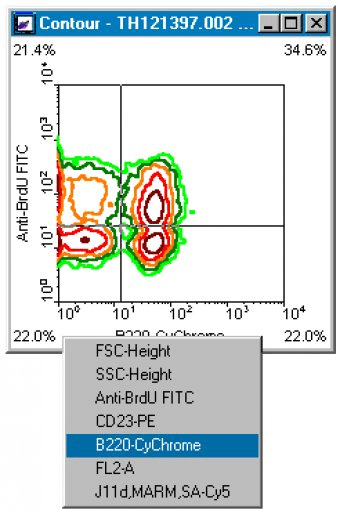
Flow cytometry bioinformatics is the application of to data, which involves storing, retrieving, organizing and analyzing flow cytometry data using extensive computational resources and tools. Flow cytometry bioinformatics requires extensive use of and contributes to the development of techniques from. Flow cytometry and related methods allow the quantification of multiple independent on large numbers of single. The rapid growth in the multidimensionality and throughput of flow cytometry data, particularly in the 2000s, has led to the creation of a variety of computational analysis methods, data standards, and public databases for the sharing of results. Computational methods exist to assist in the preprocessing of flow cytometry data, identifying cell populations within it, matching those cell populations across samples, and performing diagnosis and discovery using the results of previous steps. For preprocessing, this includes compensating for spectral overlap, data onto scales conducive to visualization and analysis, assessing data for quality, and data across samples and experiments.
For population identification, tools are available to aid traditional manual identification of populations in two-dimensional (gating), to use to aid gating, and to find populations automatically in higher-dimensional space in a variety of ways. It is also possible to characterize data in more comprehensive ways, such as the density-guided technique known as probability binning, or by combinatorial gating. Finally, diagnosis using flow cytometry data can be aided by techniques, and discovery of new cell types of biological importance by high-throughput statistical methods, as part of pipelines incorporating all of the aforementioned methods., and are also key parts of flow cytometry bioinformatics.
Data standards include the widely adopted Flow Cytometry Standard (FCS) defining how data from cytometers should be stored, but also several new standards under development by the International Society for Advancement of Cytometry (ISAC) to aid in storing more detailed information about experimental design and analytical steps. Open data is slowly growing with the opening of the CytoBank database in 2010, and FlowRepository in 2012, both of which allow users to freely distribute their data, and the latter of which has been recommended as the preferred repository for MIFlowCyt-compliant data by ISAC. Open software is most widely available in the form of a suite of packages, but is also available for web execution on the platform. Schematic diagram of a flow cytometer, showing focusing of the fluid sheath, laser, optics (in simplified form, omitting focusing), photomultiplier tubes (PMTs), analogue-to-digital converter, and analysis workstation Flow cytometers operate by suspended cells so that they separate from each other within a fluid stream.
Bio-Soft.Net>>>> Miscellaneous Software>>>>WinMDI ver 2.9. WinMDI ver 2.9: Size:2027K Language: English Directory:Miscellaneous Software. WinMDI (Windows Multiple Document Interafce for Flow Cytometry) Tweet. Download Link: Click Here (If you want to get all of the softwares in this site, PLEASE CLICK HERE) Advertise on this site.
Gold for your buildings is another limiting factor and could only be acquired by slaying your foes. Kingdom Rush PC Game Overview Kingdom Rush is a tower-defense game set in the classical fantasy/medieval world. To achieve your goal you are equipped with two spells and four basic towers – each with its own unique range and damage characteristics, upgrade tree and special abilities. Kingdom rush frontiers flash pc download. Your goal is to defend a straggling kingdom of humans, elves and dwarfs from waves after waves of rampaging goblins, orcs, trolls and other monstrosities. While each tower has its own role – barracks produce soldiers that hold your enemies, rangers do physical damage over long distance, mages do magical damage and artillery does area damage – the number of towers and their location is limited to designated plots of land.
The stream is interrogated by one or more lasers, and the resulting and light is detected. By using, particular on or within the cells can be quantified by peaks in their. These may be such as or, or they may be artificial fluorophores to detection molecules such as for detecting, or for detecting. The ability to quantify these has led to flow cytometry being used in a wide range of applications, including but not limited to: • Monitoring of count in • Diagnosis of various • Analysis of aquatic • • Measuring length Until the early 2000s, flow cytometry could only measure a few fluorescent markers at a time. Through the late 1990s into the mid-2000s, however, rapid development of new fluorophores resulted in modern instruments capable of quantifying up to 18 markers per cell. More recently, the new technology of mass cytometry replaces fluorophores with detected by, achieving the ability to measure the expression of 34 or more markers.